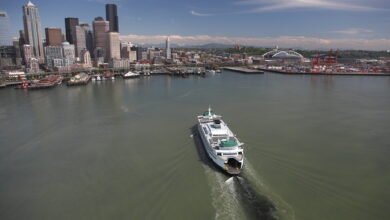Tahoe planning group exerts outsized influence on legislative oversight committee • Nevada Current

Overtourism, conflicts of interest, developer-initiated blight, vast pollution combined with microplastic contamination, and the lack of a comprehensive Tahoe basin evacuation plan are just some of the public safety and environmental problems raised by Tahoe residents during public comment at this year’s first two interim Nevada legislative oversight committee hearings.
Unfortunately, members of the Legislative Committee for the Review and Oversight of the Tahoe Regional Planning Agency (TRPA) and the Marlette Lake Water System have so far failed to pose any probing questions about these critical issues or move to have these topics explored in more detail on a future agenda. Furthermore, emails obtained in April by a resident through a public records request demonstrate an alarming chumminess between the oversight committee chair staff and the TRPA government affairs manager.
Correspondence leading up to the first two meetings reveals that the oversight committee leadership has little interest in TRPA accountability or supervision—in other words the actual job of oversight. There was, however, an extended email discussion ahead of the March 8 legislative meeting held offsite at TRPA headquarters in Stateline, NV, about snacks and lunch as part of a pre-meeting bus tour of recent tourism and development projects arranged for committee members, TRPA staff and their tourism “partners”’
During that meeting, legislators and staff barely glanced up or engaged in any way with resident-initiated topics about serious issues, including the lake’s health and the Tahoe basin’s increasing degradation and environmental threats. Some checked their email; others kibbitzed with one another and sometimes shared a private laugh. It was as if public comment was merely something to be endured.
The legislative committee’s response to agenda presenters was an entirely different story. Committee members exhibited an unusually friendly rapport and served up softball questions. After multiple references to a gathering earlier in the day it became apparent to Tahoe residents (post-tour) that Tahoe tourism presenters benefited immensely from their previous interactions.
The agenda omitted tour details so I queried the committee chair, Democratic Sen. Skip Daly, asking if the tour was an open meeting law violation. The chair never responded. The public records request provided evidence that there was email discussion about how the public might be involved, but the pre-meeting tour was never publicly noticed.
Mind you, Nevada taxpayers provide several million dollars to TRPA’s operating budget. (TRPA also derives hundreds of millions of dollars from the federal government and California.) However, legislative oversight agendas to date have been shaped to accommodate and highlight economic interests, tourism revenue and attractions, and whatever TRPA prioritizes as part of its expansive development and public relations plan.
In the late 1960s, Nevada and California governors (Paul Laxalt and Ronald Reagan) worked together to protect Lake Tahoe. But it was the Tahoe Regional Planning Compact, ratified in 1969 by Congress, that paved the way for what was supposed to be Lake Tahoe’s guardian angel: a one-of-a-kind environmental super-agency. Challenges ensued. It took a U.S. Supreme Court ruling in 2002 to keep it functioning as a check on development.
More than 20 years ago in a piece headlined Fighting for Tahoe’s Life, The Los Angeles Times wrote: “the ruling is monumental in a broad sense because it upholds the power of state, federal and local government to restrict land uses to protect the environment.”

Today, TRPA’s original mission now seems flipped on its head. In 2010, environmentalists and residents first raised the alarm about a disturbing shift taking place at the agency. Scientists employed by TRPA specializing in air, soil and vegetation got laid off. Developers are now considered TRPA’s “customers,” and the agency acts to accommodate and facilitate big-money interests that buy Tahoe land promising trophy luxury projects in Nevada and California. Two particularly egregious examples sit astride the state line in North Lake Tahoe: the former Tahoe Biltmore and Tahoe Inn. Both are now owned and controlled by private equity investor developers. Today, the properties are boarded up, blighted eyesores with none of the much touted community enhancement and environmental promises delivered.
By definition, a governmental oversight committee should flag important issues, act as a fiscal watchdog and ensure the public interest is served – particularly when key issues regarding public safety, the environment, and water quality are at stake. Some friction between an oversight committee and the agency it oversees is natural and expected. This dynamic should provide necessary checks and balances — not act as a rubber stamp or an enabler.
Furthermore, Nevada’s legislative committee is the only body with the power to exercise any sort of accountability for TRPA. California’s assembly does not have an equivalent counterpart, although nearly two-thirds of the lake sits inside our western neighboring state. There is no such federal oversight committee despite the U.S. Congress sanctioning and funding the agency. The March legislative oversight committee meeting took place before TRPA and its ‘partners’ headed to Washington D.C. to lobby for the more federal funding tied to the Lake Tahoe Restoration Act now up for reauthorization.
There are four Nevada legislative meetings left in this calendar year. The next one is May 3. Tahoe residents urge the oversight committee to refocus TRPA on what should be its core functions: protecting and restoring the now polluted lake and shorelines and enforcing codes against environmental malfeasance and overdevelopment. It should not be a tool for gluttonous developers eager to amass and hold property.
The singular natural beauty of Lake Tahoe and its surrounding basin environment — unique in its designated federal, state and local recognition and funding — should be a model for environmental protection, sustainability, water quality, and ensuring the safety of residents and visitors in the event of another catastrophic wildfire or extreme weather event.
Nevada legislators: please listen to the Tahoe residents who know the lake’s challenges and aren’t paid to give you dog and pony shows about Disney-fying Lake Tahoe.





